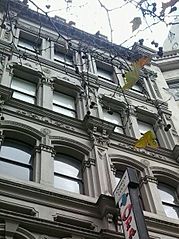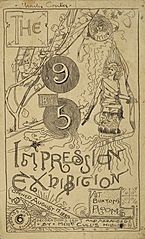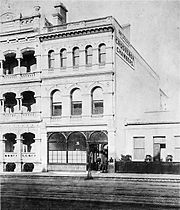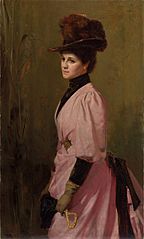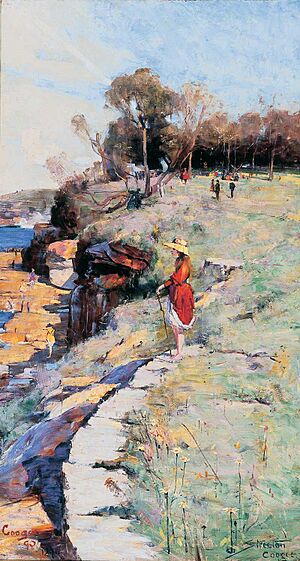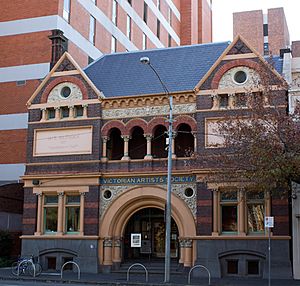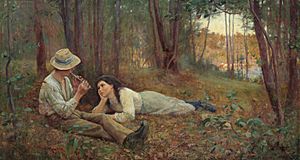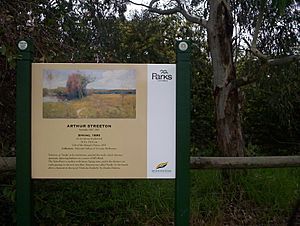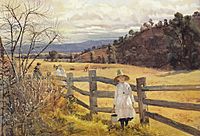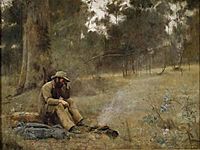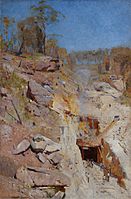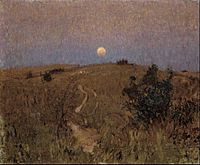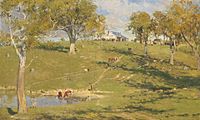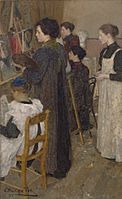Heidelberg School facts for kids
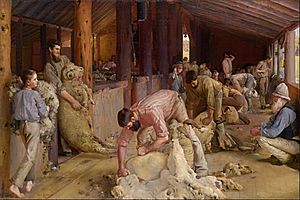
The Heidelberg School was a group of Australian artists who painted in the late 1800s. People often call their style "Australian impressionism." They loved to paint outdoors, capturing the unique light and landscapes of Australia.
An art critic in Melbourne first used the name "Heidelberg School" in 1891. He was writing about paintings by Arthur Streeton and Walter Withers. These artists painted en plein air (which means "outdoors") near Heidelberg, a rural area outside Melbourne. The term now includes artists who worked together in "artists' camps" around Melbourne and Sydney in the 1880s and 1890s.
Key artists of this group include Streeton, Withers, Tom Roberts, Charles Conder, and Frederick McCubbin. They used ideas from naturalism and impressionist art. Their goal was to show Australian life, especially the bush, and the strong sunlight typical of the country.
This art movement grew when Australia had strong feelings of national pride. Australia was then a group of colonies about to become one nation. The artists' paintings, like the bush poems of the Bulletin School, were praised for being truly Australian. By the early 1900s, critics saw this movement as the start of an Australian art tradition in Western art. Many of their famous works are in major Australian art galleries. These include the National Gallery of Australia, the National Gallery of Victoria, and the Art Gallery of New South Wales.
Contents
History of the Heidelberg School
The name "Heidelberg School" comes from the rural area of Heidelberg, east of Melbourne. This is where the artists found many of their subjects. However, the name grew to include other Australian artists who painted in similar ways.
The main group of artists painted together at "artists' camps." The first of these was the Box Hill artists' camp, started in 1885. Besides Arthur Streeton and Walter Withers, other important artists were Tom Roberts, Frederick McCubbin, and Charles Conder.
The 9 by 5 Impression Exhibition
In August 1889, several Heidelberg School artists held the 9 by 5 Impression Exhibition. It took place at Buxton's Rooms in Swanston Street, Melbourne. The main artists were Charles Conder, Tom Roberts, and Arthur Streeton. Frederick McCubbin and other students also contributed.
Most of the 183 artworks were painted on wooden cigar-box lids. These lids measured 9 by 5 inches (23 × 13 cm), which gave the exhibition its name. Louis Abrahams, who was part of the Box Hill artists' camp, got most of these lids from his family's tobacco shop.
To make the small paintings stand out, the artists put them in wide Red Gum frames. Some frames were plain, while others had poems or small drawings. This gave the art an "unconventional" and "avant garde" (new and experimental) look. The exhibition rooms were decorated in a Japanese style with screens, umbrellas, and flowers. This showed the influence of Whistler's Aestheticism, focusing on harmony and the overall effect.
The artists wrote in their catalogue:
An effect is only momentary: so an impressionist tries to find his place. Two half-hours are never alike, and he who tries to paint a sunset on two successive evenings, must be more or less painting from memory. So, in these works, it has been the object of the artists to render faithfully, and thus obtain first records of effects widely differing, and often of very fleeting character.
The exhibition created a lot of buzz. Many important people from Melbourne's 'intelligentsia' (educated people) visited during its three-week run. The public liked it, and most of the small 9 by 5 paintings sold quickly.
However, art critics had mixed feelings. The most critical review came from James Smith, a leading art critic in Australia. He said the paintings were "destitute of all sense of the beautiful." The artists famously pasted his review at the entrance. This made more people curious to "see the dreadful paintings." They also wrote a letter to Smith's newspaper, The Argus. This letter defended their freedom to choose their subjects and techniques.
The 9 by 5 Impression Exhibition is now seen as a very important event in Australian art history. About one-third of the original 9 by 5 paintings still exist. Many are in public collections and have sold for over $1,000,000 at auctions.
Grosvenor Chambers: An Artists' Hub
Grosvenor Chambers was a building made "expressly for occupation by artists." It opened in April 1888 on Collins Street in Melbourne. It quickly became the center of Melbourne's art scene. It also served as a city base for Heidelberg School artists to meet people for portraits.
The architects designed the building's lighting and interior after asking Roberts for advice. Roberts, along with Heidelberg School artists Jane Sutherland and Clara Southern, were among the first to have studios there. Soon, Conder, Streeton, McCubbin, Louis Abrahams, and John Mather also moved in.
Many artists decorated their studios in an Aesthetic style, showing the influence of James Abbott McNeill Whistler. Roberts started a trend by using eucalypts and golden wattle as decorations in his studio. He also held "conversaziones" (informal gatherings) where artists discussed new art trends and read the latest art magazines.
Because Roberts, Streeton, and Conder were at Grosvenor Chambers, many of their 9 by 5 Impression Exhibition paintings showed city views. For example, Roberts' By the Treasury was painted from his studio, showing the Old Treasury Building.
Painting in Sydney
Roberts first visited Sydney in 1887. There, he became good friends with Charles Conder, a young painter. Conder had already painted outdoors near Sydney and learned some impressionist techniques from artist G. P. Nerli. In early 1888, before Conder joined Roberts back in Melbourne, they painted together at Coogee beach.
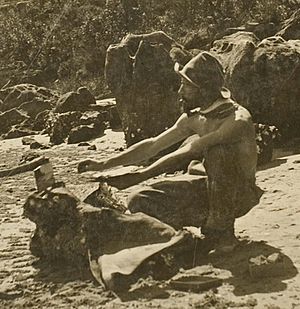
When a serious economic downturn hit Melbourne in 1890, Roberts and Streeton moved to Sydney. They first camped at Mosman Bay, a small cove in the harbour. Later, they settled at Curlew Camp, which was easy to reach by ferry. Melbourne artist Albert Henry Fullwood stayed with Streeton at Curlew. Other outdoor painters also visited, including important art teacher Julian Ashton. Ashton lived nearby at the Balmoral artists' camp.
Ashton had earlier taught Conder about outdoor painting. In 1890, as a trustee of the National Gallery of New South Wales in Sydney, Ashton helped the gallery buy Streeton's painting ‘Still glides the stream, and shall forever glide’ (1890). This was the first of Streeton's works to be bought by a public gallery. The support from Ashton and others in Sydney encouraged more artists to move from Melbourne.
Streeton became famous in Sydney for his harbour views. Many were collected by Eadith Walker and Howard Hinton, two leading art supporters. The National Gallery of Victoria notes:
Sydney became Streeton's subject. The bravura of his crisp brushwork and his trademark blue, the blue that he had used at Heidelberg, were perfectly suited to registering images of the bustling activity on Sydney's blue harbour.
From Sydney, Streeton and Roberts also traveled into country New South Wales. In the early 1890s, they painted some of their most famous works there.
Influences and Painting Style
Like many artists in Europe and North America at the time, the Heidelberg School artists used a direct and impressionistic painting style. They often painted landscapes en plein air (outdoors) and aimed to show everyday life. They were very interested in how light affected scenes and tried different brushstroke techniques.
Some art critics, like Robert Hughes, have pointed out that the Heidelberg School's "impressionism" was more like Whistler's style, which focused on tones. It was less like the French impressionists, who used broken colors. The Heidelberg School artists did not have a specific colour theory. Unlike the French artists, they often kept some traditional academic focus on form, clarity, and composition. They also sometimes created works that told a story, like Victorian painting. The Australian artists had little direct contact with the French impressionists. For example, McCubbin did not see their works in person until 1907.
The Heidelberg School painters were not just following an international trend. They wanted to create paintings that looked truly Australian. They greatly admired the light-filled landscapes of Louis Buvelot. Buvelot was a Swiss-born artist and teacher who, in the 1860s, used French Barbizon School ideas to paint the countryside around Melbourne. They saw Buvelot as "the father of Australian landscape painting."
They were not very interested in the works of earlier colonial artists. They felt those paintings looked too much like European scenes. They did not show Australia's strong sunlight, earthy colors, and unique plants. The Heidelberg School painters talked about seeing Australia "through Australian eyes." By 1889, Roberts believed they had successfully created "a distinct and vital and creditable style."
The idea that they were the first to truly capture Australia's "scrubby bush" became widely accepted in the early 1900s. However, this has since been debated. For example, art historian Bernard Smith found an "authentic bush atmosphere" in John Lewin's landscapes from the 1810s. Also, John Glover in the 1830s is seen as having accurately shown Australia's unique light and sprawling gum trees.
Artists Connected to the Movement
There was no official "membership" for the Heidelberg School. However, artists are considered part of the movement if they painted outdoors and used impressionist techniques. They also often attended the "artists' camps" in Melbourne and Sydney. Many Heidelberg School artists trained together at the National Gallery of Victoria Art School. They also held group exhibitions at the Victorian Artists' Society.
Art historians have included the following people in the movement:
- Louis Abrahams
- Julian Ashton
- Charles Conder
- David Davies
- Emanuel Phillips Fox
- Ethel Carrick Fox
- Albert Henry Fullwood
- Ina Gregory
- Tom Humphrey
- John Llewellyn Jones
- John Mather
- Frederick McCubbin
- Leon Pole
- Jane Price
- Charles Douglas Richardson
- Tom Roberts
- Arthur Streeton
- Clara Southern
- Jane Sutherland
- Tudor St. George Tucker
- May Vale
- Walter Withers
Painting Locations
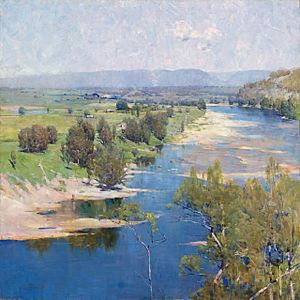
The Heidelberg School artists painted in many locations, especially around Melbourne and Sydney. Some of these places include:
- Heidelberg
- Beaumaris
- Blackburn
- Box Hill (see Box Hill artists' camp)
- Bulleen
- Templestowe
- Warrandyte
- Eltham
- Research
- Diamond Creek
- Ferntree Gully
- Kallista
- Olinda
- Mount Dandenong
- Kalorama
- Silvan
- Lilydale
- Yarra Glen
- Coldstream
- Yering
- Mentone
- Sydney artists' camps
Legacy of the Heidelberg School
In 1980, Australian artist and scholar Ian Burn said that the Heidelberg School helped shape how most Australians see the bush. He noted that "Perhaps no other local imagery is so much a part of an Australian consciousness." Their artworks are well-known to many Australians through copies. You can see them in bars, motels, on stamps, and as covers for Australian books.
Heidelberg School artworks are among the most valuable in Australian art. In 1995, the National Gallery of Australia bought Streeton's Golden Summer, Eaglemont (1889) for $3.5 million. This was a record price for an Australian painting at the time. McCubbin's Bush Idyll (1893) also briefly held the record for an Australian painting sold at auction. It sold for $2.31 million in 1998.
Many Australian films from the Australian New Wave era used the visual style and subjects of the Heidelberg School. For Picnic at Hanging Rock (1975), director Peter Weir studied the Heidelberg School for ideas on art direction, lighting, and composition. Sunday Too Far Away (1975), set on a sheep station, even recreates Roberts' Shearing the Rams painting. When filming the landscape in The Chant of Jimmie Blacksmith (1978), the cinematographer tried to "make every shot a Tom Roberts." The Getting of Wisdom (1977) and My Brilliant Career (1979) also found inspiration in the Heidelberg School. Outback scenes in My Brilliant Career directly refer to Streeton's works, like The Selector's Hut.
The Heidelberg School was featured in One Summer Again, a three-part TV show that aired on ABC in 1985. The movement was even part of the Australian citizenship test in 2007, though these history questions were removed the next year.
The movement has been shown in major art exhibitions. These include Golden Summers: Heidelberg and Beyond (1986) and Australian Impressionism (2007) at the National Gallery of Victoria. The National Gallery in London hosted "Australia's Impressionists" from 2016 to 2017. This exhibition focused on works by Streeton, Roberts, Conder, and John Russell. In 2021, the National Gallery of Victoria will host the exhibition She-Oak and Sunlight: Australian Impressionism.
Gallery
See also
- John Russell, Australian impressionist who spent much of his career in France
- Iso Rae, Australian impressionist who spent much of her career in France
General:
- Visual arts of Australia
- Impressionism
External resources
- In the Artist's Footsteps
- Heidelberg School - The Encyclopedia of Melbourne Online
- National Gallery of Victoria: Australian Impressionism Education Resource



